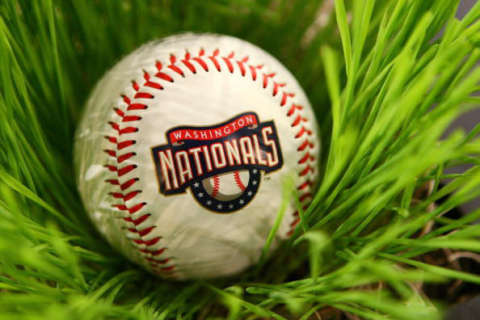Republished from The Sports Capitol with permission.
NATIONALS PARK — The race is not going to happen. There’s too much pride, danger and pesky contractual issues. Trea Turner and Michael A. Taylor will not be digging in down in West Palm Beach, Florida at Spring Training. They will not line up down the right field line with a couple racing presidents holding tape in center field for the winner to break. So, all that remains is theory.
“I have a better shot the longer the race is,” Taylor told The Sports Capitol. “I think he’s quicker off the line and I think stride length and things like that might help me out as we start to stride.”
“I would argue opposite,” Turner told The Sports Capitol. “I would think he would have me at the beginning, at the end I might be able to catch back up. I do agree he has that stride length. Let’s say you are running a 60-yard race. I feel like I’m better the last 30 yards than the first 30 yards. I don’t know. It probably would be pretty close.”
Why won’t a determining race happen?
“In my mind, it doesn’t need to happen,” Taylor said with a smirk. “He’s faster than me, and I’m OK with that.”
“I would never bank on anything [happening],” Turner said. “Because if we raced and he beat me, I would look like an idiot. And vice-versa. I’m sure he would say the same.”
There’s that. Threat of idiocy. A universal prevention issue in daily life.
Where the pair has been able to run free is on the bases this season. They are 1-2 in the National League in stolen bases. Taylor leads with 23. Turner is tied for second at 21 following Ender Inciarte stealing a base Wednesday afternoon when the Nationals were off.
The Nationals have a distant connection to the last pair of National League teammates to finish 1-2 in stolen bases. Marquis Grissom and Delino DeShields did it in 1992 for the Montreal Expos. It’s happened in the NL just four times since 1959. Taylor and Turner are on the path to do it for the first time in 26 years because each has become more adept at it, new manager Davey Martinez has provided them a green light and the Nationals’ offense needs every 90 feet it can muster.
Pitchers are fighting the pair in standard ways. Right-handers hold the ball a long time or vary their tempo. Left-handers push the limits of a supposed 45-degree angle from the edge of the rubber. That’s the line their kick leg is supposed to follow; 45 degrees or fewer back toward the body and a throw to first is not a balk. Open further, anything not to home is. It’s subjective math, if there is such a thing, and pitchers want to warp it while runners want to read it.
Taylor has always had top-end speed. Statcast had him at almost 20 mph when tracking down a fly ball last season. His athleticism is not in doubt. Same with Turner, who some argue is the fastest in the league.
However, Taylor’s 23-for-27 success rate this season, and Turner’s 21-for-23, suggest something more is going on. Let’s break it down with them.
Why they are running more, according to participants in recent (separate) conversations:
“I think we’ve been more aggressive as a team,” Taylor said. “Had the green light pretty much all season. Recently been getting on base a little bit more. So, it’s easier. I guess a combination of a lot things.”
“Dusty would put on the red light sometimes, but (first base coach) Davey Lopes would kind of override it,” Turner said. “We probably got the red light a little bit more often in years past, but at the same time, I think we had all the opportunities to run that we do now. I would say it’s pretty even.”
SUBSCRIBE TODAY | Like this article? Support The Sports Capitol by subscribing today.
How to fight pitchers holding the ball:
“I think over the years, I’ve become better at kind of waiting,” Taylor said. “Not getting too anxious or jumpy when the pitcher holds the ball. A lot of times, that’s their No. 1 defense. Just being in a position where you’re relaxed and you can kind of just wait while they hold, then you’re ready to go whenever they go.”
“I think at some points, you’ll rely on the hitter to call time, get you out of there, kind of do you a favor a little bit,” Turner said. “But, also, for me and Mikey as well, if we’re on first base and they’re putting that much effort into us, there’s a good chance they’re going to make a mistake to whoever’s up at the plate. Sometimes I tell myself it’s OK not to steal because they’re so worried about me being here, that if I got to the next base, they don’t have to worry about me here. It’s a different situation. Yes, I’m in scoring position, but that kind of anxiety of ‘Is he going to steal?’ isn’t there anymore. I think there’s advantages to just be on base in general and be a threat. If they’re paying that much attention, holding the ball that much, I think that helps your teammates.”
Any tension while taking a lead can slow Taylor by putting him out of position or just simply causing an abandonment of running.
“You can start leaning, get too much weight on your front foot because you’re ready to go, you’re ready to go, but he’s holding the ball, all of a sudden he comes over, you get picked,” Taylor said. “Or, you feel like you’re sitting there for so long, that eventually you just shut it down are some things that happened to me in the past when guys hold the ball for an extended period of time.”
The pair spent two years with Lopes, considered a guru of base stealing, as the first base coach. That time put more options in Taylor’s pocket, ones he wants to keep there.
“There are a lot of things,” Taylor said he learned from Lopes. “I won’t really touch on too many of them because I think he taught me some things that give me an edge. I think the biggest thing is the mentality. He was very aggressive. If a guy was giving us an opportunity to give us a bag, he didn’t let it pass by. That’s how I try to go about it this year. If he’s slow enough to the plate and it’s a good situation to run, I’m not going to overthink it.”
That brings us to the left-handers. Commonly, they are taught a “nickel, dime, quarter” approach to throwing to first. The nickel is a straight step toward the bag followed by a modest toss. The dime is a straight step and hard throw. The quarter is the full move: leg kick, angle toward home (while looking to the plate) followed by a hard throw to first.
“It changes from guy to guy,” Taylor said. “Some guys will have certain tells and things you can get a jump off of. Some guys are readers and they’re kind of hanging in the air a little bit to see what you’re going to do. The 45-degree balk rule is kind of a blurred line I think. Some guys get away with maybe a little bit of a balk. There’s not much you can do about it in that situation, They’re trying to deceive the runner and make it look it look like they are going to the plate, and they get away with it sometimes.”
“Lefties are different,” Turner said. “Some people are really good at making it look the same. Some people are really obvious it’s coming over. I think it’s kind of a feel thing with me. I can generally see when he made a move to home plate. He’s loaded his weight or moved his weight down the mound, then at some point I need to turn my eyes to home plate to watch the ball cross home plate. It’s funny because [on a recent] pick off, I didn’t see him throw the ball over. I looked at home plate waiting for the ball, then I was like, ‘The ball’s not at home plate.’ That’s what happened there. I thought I had saw him make his move to the plate, so I moved my eyes and ended up getting picked off.
“For me, I just think one, it’s either a balk, or if not, it’s a really, really good move. I think you kind of got to tip your hat to those guys. It doesn’t happen too often, thankfully. Once, twice, three times a year. If you’re going to be an aggressive base runner, that’s OK with me. Obviously, you want to limit those as much as possible. But, there’s going to be a guy every now and then that has a really good move. You have to be prepared and battle over there. It’s like battling with two strikes at the plate. You’ve got to battle over there at first base and make sure you’re not too far one way or the other. You want to make sure you’re ready to advance, but you don’t want to get picked off. It’s kind of like an ebb and flow.”
The Nationals’ outfield overload will challenge their chances to finish 1-2. Taylor’s playing time has devolved into more of a platoon despite his recent leap at the plate. Turner will continue to play as the everyday shortstop. Inciarte is also a wrinkle. He and the Nationals’ pair are already creating a gap between themselves and the field.
However, if they stay healthy, and running, Taylor and Turner could grab a slice of history this season.
Todd Dybas is the managing editor and co-founder of The Sports Capitol. He has spent 17 years in the sports editorial industry, working as a writer and layout editor, winning multiple awards in both positions. He has been an NFL beat writer, has worked as a member of the Baseball Writers’ Association of America for seven years, and is a member of the Pro Basketball Writers Association.







